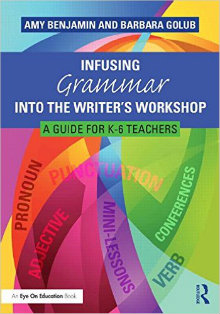Infusing Grammar into the Writer’s Workshop
Infusing Grammar into the Writer’s Workshop: A Guide for K-6 Teachers
By Amy Benjamin and Barbara Golub
(Routledge/Eye On Education, 2016 – Learn more)
Reviewed by Marci Warboys
I am a middle school special education teacher currently working with seventh and eighth graders. I realize this book is written for grades K-6, but I figured I should give it a whirl anyway.
The population with which I work can definitely benefit from instruction that may be “stickier” than the instruction they have received in their earlier academic lives. In my world of modification, remediation, and supplementation, I am always looking for new methods that work.
Infusing “extra” grammar

It is important to me to utilize an authentic medium for mini-lessons and grammar instruction, while avoiding the stress and ineffectiveness of attempting to fit in isolated lessons to cover unconnected material.
In my quest for pedagogy with adhesive properties, this particular quote from the book resonates with me: “The human brain loves to have names for things, and terminology is most likely to stick when accompanied by the concept-in-action, rather than when ´taught´ as a definition, outside of its context” (3).
Anything that will help my students retain and generalize what they have learned is worth attempting in my mind!
Seeing and hearing
In Chapter One, “A Look at Balanced Literacy and Reading-Writing Workshop,” Barbara Golub does a wonderful job modeling how to naturally infuse grammatical terminology into the different components of the workshop model. She explains that “[w]hen students hear terminology being used as the concept is applied right before their eyes, it’s not as daunting as you may think” (2). I like how Golub identifies where and when in the workshop components particular skills can be taught more naturally and fluidly, making this task ¨less daunting¨ for the teacher as well.
In Chapter Two, “Accelerated Auditory Patterning: How Is Standard English Supposed to Sound?” Amy Benjamin provides valuable background information on how children acquire language skills, specifically for the skill of conjugating verbs. From this foundational knowledge, she shares games and activities that provide the needed stimulation, such as repetition and rhythm, to learn and generalize this concept. The games and activities delineated in the chapter provide the needed patterning through hearing that is required for learning these grammatical concepts and seem to me like they would make the learning fun and engaging.
Also in Chapter Two, Golub piggybacks off of Benjamin’s work by providing the structure for how to implement these games and activities for teaching grammar lessons within the workshop model. She provides a five session procedure that can be implemented in the first ten minutes of the workshop each day. After the five sessions, the class is also left with a visual teaching aid to refer to for future use. This procedure can then be reused to teach different concepts in five session intervals.
Theory and practice
I like the practical set up of this book. Chapters Three and Four follow the same format where Benjamin gives the research and pedagogy required to obtain the different concepts of that chapter. Golub then provides the logistical steps for planning, scripts for each lesson, and additional teaching resources in her section.
Each chapter provides a series of sessions structured to meet the needs of different grade levels. In Chapter Three, the authors tackle complete sentences, run-on sentences, and comma usage in both a second grade and kindergarten classroom. They then show us how to use the ¨Inquiry Method¨ in a fourth grade classroom to teach these same concepts in a more sophisticated, student-centered way.
Chapter Four focuses on parts of speech in a fifth grade classroom, using morphology charts and sentence frames to help identify and change parts of speech. Chapter Five demonstrates how to teach our students to build upon nouns and verbs with phrases and clauses to “say more” in their writing.
I will say that I tried the Inquiry Method in Chapter Three to teach my eighth graders about articles. I was skeptical at first, but to my delight, the students were fully engaged in the learning process and surprised me with the information they discovered together. They now have a much better understanding of when to use a versus an, and why to use the rather than the former. We also have a student created classroom resource to reference.
Thanks, Amy & Barb!
Marci Warboys is a grades 7/8 special education teacher in the Montgomery Township (NJ) School District.


































